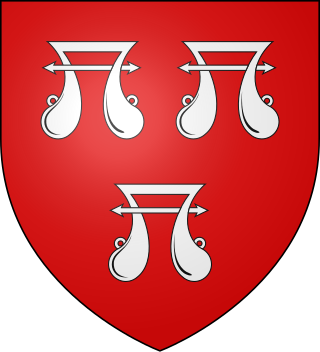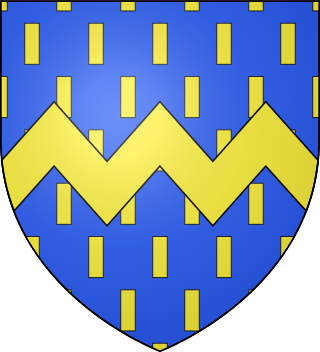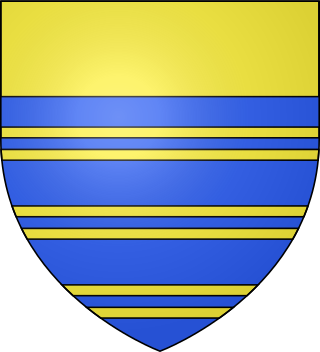
Baron Audley is a title in the Peerage of England first created in 1313, by writ to the Parliament of England, for Sir Nicholas Audley of Heighley Castle, a member of the Anglo-Norman Audley family of Staffordshire.

Baron de Clifford is a title in the Peerage of England. It was created in 1299 for Robert de Clifford (c.1274–1314), feudal baron of Clifford in Herefordshire, feudal baron of Skipton in Yorkshire and feudal baron of Appleby in Westmoreland. The title was created by writ, which means that it can descend through both male and female lines. The Norman family which later took the name de Clifford settled in England after the Norman Conquest of 1066 and was first seated in England at Clifford Castle in Herefordshire. The first Baron served as Earl Marshal of England but was killed at the Battle of Bannockburn in 1314. His 8th generation descendant the 11th Baron, was created Earl of Cumberland in 1525, whose grandson the 3rd Earl was a noted naval commander. On the latter's death in 1605, the earldom passed to his younger brother, the 4th Earl.
Baron Lisle was a title which was created five times in the Peerage of England during the Middle Ages and Tudor period, and once in the Peerage of Ireland in the 18th century.

William Ros or Roos, 1st Baron Ros of Helmsley, was one of the claimants of the crown of Scotland in 1292 during the reign of Edward I.
Baron Boteler was a title that was created three times in the Peerage of England.

The titles Baron Montacute or Baron Montagu were created several times in the Peerage of England for members of the House of Montagu. The family name was Latinised to de Monte Acuto, meaning "from the sharp mountain"; the French form is an ancient spelling of mont aigu, with identical meaning.
Edward Vaux, 4th Baron Vaux of Harrowden was an English peer. He was the son of George Vaux (1564–1594) and his wife Elizabeth Vaux, and the grandson and heir of William Vaux, 3rd Baron Vaux of Harrowden. He succeeded his grandfather as Baron Vaux of Harrowden in August 1595, just before his seventh birthday.

Baron Willoughby of Parham was a title in the Peerage of England with two creations. The first creation was for Sir William Willoughby who was raised to the peerage under letters patent in 1547, with the remainder to his heirs male of body. An error in identifying the heir in 1680 resulted in an inadvertent novel creation by writ in 1680, without the restriction on inheritance by gender. The creation of the barony gave the right to a hereditary peerage and seat in the House of Lords, the upper house of Parliament.

Thomas Burgh, 3rd Baron Burgh KG 3rd Baron Borough of Gainsborough, de jure7th Baron Strabolgi and 9th Baron Cobham of Sterborough was the son of William Burgh, 2nd Baron Burgh and Lady Katherine Clinton, daughter of Edward Clinton, 1st Earl of Lincoln and Elizabeth Blount, former mistress of King Henry VIII. He was one of the peers who conducted the trial of the Duke of Norfolk in 1572.
Baron Astley (1295) was created by writ of summons dated 23 June 1295 for a family which had lived at Astley, Warwickshire, England since the time of Henry I. Sir Thomas de Astley who was killed in the Battle of Evesham in 1265 married twice. From Sir Thomas's first marriage to Joan de Blois descended the Barons Astley.

Ralph de Greystoke, 3rd Baron Greystoke, was an English peer and landowner.

Baron Everingham is an abeyant title in the Peerage of England. It was created by Writ of summons to Parliament of Adam de Everingham of Laxton, Nottinghamshire, on 4 March 1309. It passed to his son Adam but fell into abeyance upon the death of his childless grandson Robert in 1371.

Sir Ralph Euer, also known as Ralph de Eure, of Witton, Stokesley, Berwick Hill, Darreshall, Kirkley, Felton, Ayton, Malton and Boughton Spittle was an English knight and servant of the Crown and of the Bishops of Durham. He was also a Member of Parliament for Northumberland and Yorkshire.

Baron Aton is an abeyant title in the Peerage of England. It was created by Writ of summons to Parliament of Gilbert de Aton of Ayton, North Yorkshire on 30 December 1324. It passed to his son William, but fell into abeyance upon the death of William without male heirs in 1373.

Sir Adam de Everingham, 2nd Baron Everingham, Lord of Laxton, was an English noble who fought during the Second War of Scottish Independence and the Hundred Years' War.
William Touchet, 1st Baron Touchet, Lord of Lewenhales was an English noble. He fought in the wars in Scotland and Gascony. He was a signatory of the Baron's Letter to Pope Boniface VIII in 1301.

Edmund Deincourt, 1st Baron Deincourt, Lord of Thurgarton, Blankney and Branston was an English noble. He served in the wars in France and Scotland and was a signatory of the Baron's Letter to Pope Boniface VIII in 1301.

Alan de Plugenet, 2nd Baron Plugenet, Lord of Preston Plucknett was an English noble. He served in English campaigns in Scotland.

William de Rithre, 1st Baron Rithre, Lord of Rithre was an English noble. He fought in the wars in Gascony and Scotland.

Nicholas Meinill, 1st Baron Meinill, Lord of Whorlton was an English noble. He fought in the wars in Wales and Scotland.














